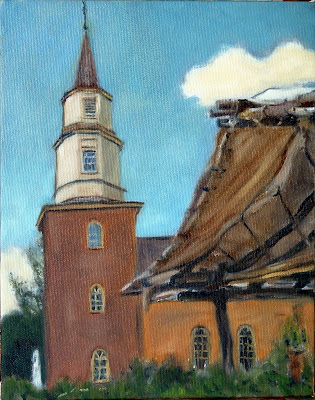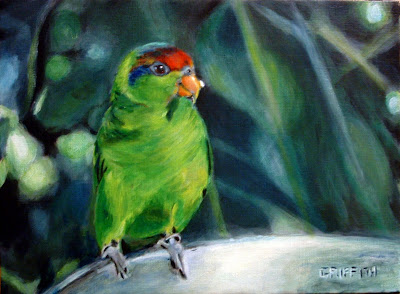Saturday, January 31, 2009
On the Bubble Bailout
I post a lot of goofy videos on this blog, but this one is informative and important. May I suggest you watch it?
Friday, January 30, 2009
Golden Rose-Burnt Umber Stage 1
Wednesday, January 28, 2009
Golden Rose-Imprimatura Stage
The Apple

I touched up the Apple painting a bit. I originally painted this picture almost a year ago. At the time I was just learning how to paint indirectly with glazes. I had let the painting dry thoroughly and I glazed some colors over the entire painting. I ruined it! Well, I didn't actually ruin it, because with oils you can always go back and fix any problem. And that's what I did this evening. I painted over the entire thing and established details.
Also, on the older version the apple was not symetrical; it was lopsided on the top right side. Click here to see. You'll not see much of a difference, but again, I had to fix it. I never posted the ruined version... you'll have to use your imagination.
Sunday, January 25, 2009
Little Cheep-Color Stage 3
Saturday, January 24, 2009
Little Cheep-Color Stage 2

I spent a little over an hour on this stage and I concentrated on "the bird." I'm surprised at how vivid his colors became on this second layer.
I'm having somewhat of a difficult time with that thing he's standing on. I'm not exactly sure where to put highlights and shadow.
I have not messed with his feet at all since the dead layer. I need to work on them.
He's missing the highlight on his pupil. I plan to put one little speck of Titanium White there when I get him finished. I hope that will make him spring to life. Let's hope he's a nice bird and does not fly away!
Tuesday, January 20, 2009
Little Cheep-Color Stage 1

I am a little nervous and excited each time I apply the first layer of color to a painting. It changes the look so drastically.
I bought a bit of Liquitex Slo-Dri Blending Gel at the arts and crafts store. I put a dab on my pallette, mixed the colors and added the paint to the gel. I made sure my brush was good and wet with water and I dipped it into a tiny amount of paint. I glazed it onto the surface, spreading it out evenly over the canvas. The gel slowed down the drying time just enough so it did not dry too quickly. It seems to have worked well.
Little Cheep looks a little pale at this stage, (that is exactly the way I intend for him to look right now) but he'll brighten up with each successive glaze of color. He's a noble beast...
Saturday, January 17, 2009
Little Cheap-Dead Layer Stage 2
Thursday, January 15, 2009
Bruton Parish-Final Stage

"Bruton Parish"
8"x"10 Acrylic on Canvas
With this final layer, I was chiefly concerned with tweaking details. It's the little extra push that makes a painting resemble reality: a shadow here, a highlight there, a light on a blade of grass, a reflection in a window.
I will allow it to dry for several days and then I'm going to ship it to my Aunt Mary who lives in Williamsburg.
Wednesday, January 14, 2009
Little Cheap-Dead Layer Stage 1


This stage is called the Dead Layer, also known as the Penumbra. I've included two images to show the process. As you can see from the image on the bottom, I painted the bird first and then the background. You can still see bits of the umber layer showing through at his feet, and those bright objects (whatever they are !) in the background. Again, this is somewhat rough at this point, and I hope to refine details on the next stage, but it's coming together, like a paint-by-number.
This color is technically not black and white. I've mixed Mars Black, Phthalo Blue, and a small amount of Burnt Sienna, Burnt Umber and Light Yellow, along with white. It is supposed to look like moonlight. I'm pleased with the results, but I'm stessed! Reason being is the acryllic paint: I'm not used to paint drying so quick! I have to move fast, just to be able to use what I've mixed on my pallette.
Tuesday, January 13, 2009
Little Cheep-Umber Stage 2

I've glazed opaque highlights and re-established shadows. This is only two colors so far. Burnt Umber (or brown) and white. Next phase will be the dead layer. This is a greyscale stage that will completely cover the stage you see above. I'm nervous. I like this little guy and I'm afraid I'm going to mess him up!
Monday, January 12, 2009
Little Cheep-Umber Layer Stage 1

It looks a mess at this first stage of painting. It reminds me somewhat of sculping: You start with an unformed lump and keep working until it looks like something.
I overdid it with the shadows. This acryllic stuff dries so fast I can't control it! I will paint another layer of shadows and darken the darkest shadows. The next stage will be to glaze opaque highlights into the lighest parts.
Little Cheep- Grisaille Image

This is the black and white image I will use to paint from in order to establish my underpainting. I did not take this picture myself but obtained it from a photo library on Wet Canvas. I bumped up the contrast a bit and lightened the overall picture. I want the underpainting (the black and white stage) to be slightly lighter than the finished picture. When I begin to glaze colors over the underpainting, the overall picture tends to darken somewhat. My goal is to tackle problems in the early stages.
Bouguereau-Young Gypsies
Little Cheep-Imprimatura Stage

I attempted to lay down an olive imprimatura. The acryllic paint dried within just a few minutes and I was not able to smooth it out like oil paint.
I successfully transferred drawing onto acrylic primed canvas, but I ran into somewhat of a snag with this drawing. In the last post I mentioned I would paint this picture with acrylic paints rather than oil. When I transferred the drawing from tracing paper, (I outline the back of the paper with charcoal, tape to the canvas, and then go over the drawing on the front side with ball point pen), I realized the charcoal behaves differently on acrylic. Although it looked great, I was able to rub it off with my finger! So I re-outlined the drawing with a red colored pencil, and that is what you see in the above image. My next step will be to paint with Burnt Umber, (brown).
Sunday, January 11, 2009
Little Cheep-Drawing Stage 1

I'm working on a new painting for my daughter. I'm going to try to paint this one with acryllics and are you ready? (drumroll please....). I'm going to paint it using the 7-layer Flemish technique!
I've off-set the little cheep slightly to the left of the canvas. As you can see in the computer moniter, he's centered in the original picture, but of course if you know anything about Euclidean Geometry, you are aware that I've put him in the golden ratio. Ought to be fun.
Saturday, January 10, 2009
Bruton Parish-Color Stage 4
Isley Brothers-This Ol' Heart of Mine
Wow! One of my all time favorites and we get to hear it on vinyl too! I find the drums and the combination of strings and horn section to be remarkable.
This song is a good example of how something can be simple without being simplistic. The melody is simple yet beautiful and it is sung with passion.
Tuesday, January 6, 2009
Bruton Parish-Color Stage 3

I was at the local art store this past weekend and picked up a tube of Prussian Blue and Flake White. I'm surprised at the strength of the Prussian Blue and I'm also surprised at the transparency of the Flake White. I made sure I washed my hand really well after this session because the Flake White had a serious cancer warning on the back. Yikes!
I plan to have one more session on this painting before I finish. I'm pleased with the results so far. The next session I will try to darken the shadows, draw out the highlights, interject light green areas into that grassy stuff up close, at the bottom, and put more character and age on those old bricks.
Friday, January 2, 2009
Bruton Parish-Color Stage 2

I've applied second layer of color. This time, rather than rubbing Liquin onto canvas, I rubbed a medium mixture of Turpentine, Damar Varnish, and Linseed Oil. I have a tendency to major on the minors in these early stages, i.e. lattice work on windows, wires holding tarp onto canopy, etc.. On the cloud and the bright part of the steeple I glazed a thin layer of Titanium White and Burnt Sienna. Definitely one more stage, probably two andI'll finish.
Thursday, January 1, 2009
Bruton Parish-Color Stage 1

I have applied the first layer of color. On this application I actually dip my finger, (rather than a brush) and apply Liquin directly to the canvas. I rub it on very thinly, covering only the areas I will paint. I dip my brush (I'm used a soft-sable filbert, #2), into turpentine and apply the paint in thin layers rubbing into until it looks smooth. Keep in mind, I used just a little bit of paint. This way of painting reminds me of watercolors as you can still see the underpainting beneath. If I could not see the underpainting, I would know I'm putting it on too thick. These early stages require a thin smooth surface as there will be other layers to come. I save the impasto, or thick stages for the final sessions.
I did not prime my canvas with Gesso and sand on this painting so I'm finding the paint sinks into the grooves and makes the canvas look dirty, until I smooth it out. This is a little aggravating. I make my own canvas' out of 1"x2"'s I picked up at Lowes. When I prime and sand it leaves a smooth mark where the wood ends beneath the canvas and doesn't look good. I could by stretcher bars at the local craft store, but I'm cheap!
I will now need to let this dry thoroughly before I start with the second application. The colors look nice compared with the grisaille, or greyscale, but they still look faint, like an old-timey tinted photo, but with each stage the colors become more vivid and the details emerge.
Subscribe to:
Posts (Atom)





_-_Young_Gypsies_(1879).jpg)
